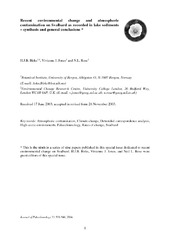| dc.contributor.author | Birks, Harry John Betteley | eng |
| dc.contributor.author | Jones, Vivienne J. | eng |
| dc.contributor.author | Rose, Neil L. | eng |
| dc.date.accessioned | 2007-12-06T11:44:32Z | |
| dc.date.available | 2007-12-06T11:44:32Z | |
| dc.date.issued | 2004 | eng |
| dc.Published | Journal of Paleolimnology 2004 31 (4): 531-546 | en |
| dc.identifier.issn | 1573-0417 | en_US |
| dc.identifier.uri | https://hdl.handle.net/1956/2479 | |
| dc.description | This is the ninth in a series of nine papers published in this special issue dedicated to recent environmental change on Svalbard. H.J.B. Birks, Vivienne J. Jones, and Neil L. Rose were guest editors of this special issue. | en |
| dc.description.abstract | The major patterns of biostratigraphical and geochemical change detected in a multidisciplinary study on recent environmental change and atmospheric contamination on Svalbard are summarised and synthesized. The patterns discussed are changes in sediment accumulation rates, organic matter accumulation rates, atmospheric contaminants, and biological assemblages (diatoms, chrysophyte cysts, chironomids). Possible environmental factors that may have influenced these patterns are discussed, in particular the role of atmospheric contamination (including the deposition of nitrogen-compounds), local human impact, and recent climatic change. The major conclusions are (1) sediment accumulation rates show consistent temporal and geographical patterns with rates increasing towards the present-day and highest in the south, (2) sediment organic-matter accumulation rates increase markedly in the last 50 - 100 years, (3) atmospheric contamination is a combination of local and regional sources, (4) sediment inorganic geochemistry suggests catchment and lake responses to climate change in the last 30 - 50 years, (5) all lakes show a marked increase in the rate of biotic compositional changes in the last 50 - 100 years, and (6) Svalbard lakes appear to be highly dynamic and show considerable biotic and sedimentary changes in recent decades. The most likely cause of many of the observed changes is recent climatic change, with some local human activity at one site. Detailed interpretation of the observed changes is problematic given current limited knowledge about high Arctic limnology, biology, and catchment processes. | en_US |
| dc.language.iso | eng | eng |
| dc.publisher | Springer | en_US |
| dc.subject | Atmospheric contamination | eng |
| dc.subject | Climate change | eng |
| dc.subject | Detrended correspondence analysis | eng |
| dc.subject | High-arctic environments | eng |
| dc.subject | Palaeolimnology | eng |
| dc.subject | Rates of change | eng |
| dc.subject | Svalbard | eng |
| dc.title | Recent environmental change and atmospheric contamination on Svalbard as recorded in lake sediments – synthesis and general conclusions | en_US |
| dc.type | Peer reviewed | |
| dc.type | Journal article | |
| dc.identifier.doi | https://doi.org/10.1023/b:jopl.0000022550.81129.1a | |
| dc.subject.nsi | VDP::Matematikk og Naturvitenskap: 400::Zoologiske og botaniske fag: 480 | nob |
